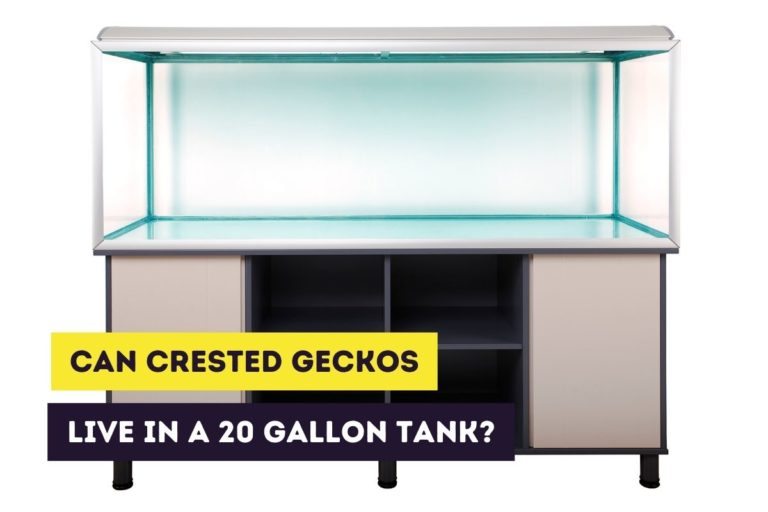Crested Gecko Enclosure Guide (With Tips and Tricks)
When you get your crested gecko, you’ll need a habitat (also known as vivarium or terrarium) to keep him in. Crested geckos need relatively small but high cages. A crested gecko is a (semi-)arboreal animal that loves to jump and climb.
Crested geckos need a vertical enclosure such as a cage, a tank, or a terrarium. The general term for such an enclosure is a vivarium. A vertical enclosure allows your arboreal crested gecko to climb and jump around. The size of the enclosure will depend on the age and size of your crested gecko.
The enclosure is probably the item you’ll spend the most money on. It’s essential but a good enclosure (including substrate and plants) will cost several hundred dollars. It’s a good idea to know exactly what enclosure you need so you don’t have to buy another one after a year or so.
In this article, you’ll learn everything there is to know about crested gecko cages. At the end of this article, you’ll know what type of enclosure to choose and what size you should get. You’ll also get an idea of the perfect cage location in your home.
If you’re interested in stickers or other products of crested geckos, you can always visit our Etsy Shop, which is called Artful Animalia. We currently only send stickers in the United States. If you’re interested in certain crested gecko-related products, don’t hesitate to contact us.
This site contains affiliate links to products we recommend and use ourselves. We may receive a commission for purchases that you make through these links. If you’re interested in learning more about our affiliate links, please visit our (affiliate) disclaimer.
Natural Habitat of Crested Geckos
Wild crested geckos are mostly solitary creatures that will live most of their lives alone and come together to mate. Crested geckos live in rain forests and inhabit the lower areas of the forest near the ground floor. They love to jump and climb on the branches and plants while searching for food and exploring their territory.
Housing Crested Geckos
Crested geckos are easy to house and have adapted fairly well to living in captivity. They don’t require large housing and can be kept in enclosures of 10 to 30 gallons, depending on the number of crested geckos you want to house.
Before I’ll discuss the size of the enclosure, it’s important to know more about the types of enclosures there exist. So first, you’ll get to know a little bit about the different housing types there are available for crested geckos.
Types of enclosures
The most common types of enclosures for small reptiles such as crested geckos are:
- a terrarium
- a vivarium
- an aquarium
- a screen or mesh cage
Terrarium
A terrarium is a glass enclosure that typically contains only soil and plants. Terraria have openings to take care of the plants. Most terraria have a purely decorative or ornamental function.
However, when you go looking for housing for your crested gecko or other reptiles you might often see the term terrarium. This is because there is a lot of confusion about the terms terrarium and vivarium and some sites will use the term terrarium for a vivarium. This is perfectly fine when you know what they mean by terrarium.
Vivarium
The “correct” term for reptile enclosures is a vivarium. The word means “a place of life” in Latin and is exactly that. A vivarium is used to house small animals and will mostly be used for housing reptiles and amphibians. Most people will mimic the natural habitat of the animal in the vivarium, which often means adding plants and branches (hence the confusion with a terrarium).
Vivaria can be small or large, depending on the size of the animal, the number of animals and your personal preference. If you have a lot of space you can even create a room-sized vivarium outdoors, but most of you will settle with a smaller vivarium that can be placed on a table or cabinet.
Aquarium
An aquarium is another kind of enclosure that is used for plants and small aquatic animals. Contrary to a terrarium or a vivarium, an aquarium contains water and is most commonly used to keep fish. There are, however, other uses for an aquarium and they can be used to house reptiles when you’re a little bit handy and can make the necessary adjustments.
Screen or mesh cage
A mesh cage is often used to keep rodents in but they can work fine for some reptiles and crested geckos are one of them. A screen or mesh cage consists of a frame that’s usually made of plastic or aluminum. Next, a screen or mesh is pulled over this frame and is zipped on one or more sides. The mesh can be made of fiberglass, nylon or plastic and provides good ventilation while also making it easy to mist the enclosure.
Crested gecko habitat
In captivity, the perfect habitat for a crested gecko would be one that mimics their natural habitat as closely as possible. This is often not that easy unless you create a bio-active vivarium, but with the right type of enclosure, substrate, and plants you can make your crestie happy and comfortable.
Criteria for a good enclosure
A good enclosure for a crested gecko will meet the following criteria:
- escape-proof: you don’t want your crested gecko escaping and getting out in the dangerous outside world or be eaten up by other pets you might have. Catching an escaped gecko can be very difficult so you want to be sure that the enclosure is at least escape-proof.
- proper ventilation: an enclosure will need to have enough ventilation without being in a draft. Mesh cages can be perfect for ventilation but can also cause respiratory problems when there’s a draft.
- right humidity: humidity is created by daily misting of the enclosure and can be accomplished in most enclosure types.
- comfortable temperature: crested geckos are most comfortable in an enclosure with room temperature. You usually don’t need any special heating equipment, except in colder climates or in winter. But some enclosures can heat up faster than others, so you take this into consideration when choosing one.
- enough space: crested geckos don’t need a lot of space and will usually be perfectly fine in an enclosure of 10 to 20 gallons. You should make sure that your enclosure is big enough for the number of geckos you want to house. Most of you will only get one crested gecko and won’t need a very large enclosure. On the other hand, large habitats are almost always better for the happiness of your crestie.
- climbing possibilities: a crested gecko is a (semi-)arboreal species that loves to climb and this means that you’ll need to have plants and branches in the enclosure. This also means that you’ll need a vertical habitat more than a horizontal habitat. Height is essential for a crested gecko habitat!
What enclosure to choose for a crested gecko?
As I already mentioned there are a lot of different enclosure types but for a crested gecko there are three types I would recommend:
- the vivarium: the most commonly used enclosure for a crested gecko. There are a lot of different brands that have vivaria.
- the (remodeled) aquarium: an aquarium can be made into a vivarium with a few tiny adjustments to provide enough ventilation.
- the screen cage: a screen cage offers climbing possibilities and is easily set up.
There are pros and cons for each type and you’re free to choose the one that fits best in your situation.
A vivarium or aquarium is often better to keep the humidity at a decent level and will be a bit easier to clean, but they’re at a higher risk of overheating when in direct sunlight. A screen cage will have better ventilation but, when you live in a dry or moderate climate, keeping the humidity up can be more difficult.
Minimum size
When it comes to sizes of enclosures, the bigger is usually better. But what should the minimum size be of a crested gecko enclosure?
There are some different views on the right size but most authorities will recommend the following minimum sizes for a crested gecko:
- hatchlings and juveniles up to 10 grams: enclosure between 1.5 and 5 gallons
- juveniles between 10 and 25 grams: enclosure between 7 and 10 gallons
- adults weighing more than 25 grams: enclosure of 20 gallons for one crested gecko or 30 gallons for pair of crested geckos.
Hatchlings and juveniles will need smaller enclosures because they’ll have more trouble finding food in a large cage. They need a small environment with a few plants and don’t require a lot of elaborate climbing possibilities.
A single adult crested gecko can live in a 20-gallon or larger enclosure. Some crested geckos will find 20-gallon enclosures or larger too large and will start being unhappy. You can quickly notice this when your crested gecko starts losing weight.
When housing multiple crested geckos you should add 5 gallons to the minimum size for each extra crested gecko.
There are some well-known brands that offer special crested gecko habitats. These habitats usually come in a small (12x12x18 inches) and a large (18x18x24 inches) size.
Location
Location is one of the most important things when it comes to property. The same goes for the location of your crested gecko enclosure. Take the following into consideration when choosing a location for your enclosure.
Exposure to sunlight
Crested geckos are crepuscular and nocturnal pets. They are awake during the night with peaks of activity at dawn and dusk. In captivity, crested geckos will use the light in the room as a guide for their sleeping habits. Place the enclosure in a location where the crested gecko experience a normal day/night light cycle.
Never put the enclosure in direct sunlight! Direct sunlight can heat up the enclosure fast and your crested gecko might suffer heatstroke.
Temperature
Crested geckos live in a region where temperatures can get high. But at the times that the temperatures get too high crested geckos are less active and will stay in their cooler hiding places near the forest floor. Crested geckos can’t stand extreme low and high temperatures and can suffer from long exposure to such extremes. They’re better in a room where there is a normal room temperature.
In captivity, crested geckos can’t really hide in very cool hiding places if the temperature is high. In regions with a mild climate, the temperature will seldom be a problem. But it’s still important to know that, when temperatures do get high, your crested gecko needs to stay cool. You can do this by relocating them to a cooler location or by using air-conditioning in the room. Just make sure that the cage isn’t located near the air-conditioning system itself as this might cause respiratory diseases.
In the winter, make sure that your crested gecko stays warm. Since crested geckos don’t use nesting material, they won’t have a way to stay warm when it gets too cold. You should heat up the room to room temperature. As is the case with the air-conditioning and ventilation, don’t place the cage near the heat of a radiator or similar devices. This might cause overheating.
The best temperature for your crested gecko is a steady room temperature between 72 and 78 degrees Fahrenheit (21 and 25 degrees Celsius) during the day. During the night they can handle lower temperatures. At night the temperature should range between 69 and 74 degrees Fahrenheit (20 and 22 degrees Celsius). Crested geckos can handle lower and higher temperatures but shouldn’t be kept for long periods of time at these temperatures.
Placement
A final important aspect of the enclosure location is the placement itself. You should place the enclosure:
- on waist level or higher: crested geckos are prey animals and are preyed upon by birds. Their natural instinct is to run when they encounter a predator or bite in extreme cases. You should approach your crested gecko from the same height and your crestie should always be able to get to a level that’s the same height as yourself.
- away from ventilation, radiators, direct sunlight, and cold spots: crested geckos are sensitive creatures and can get a heat stroke when exposed to high temperatures for extended periods. But when the enclosure is located near a cold spot, they also can get sick and can get respiratory diseases.
“Bad” enclosure locations
There are some locations that are more suitable than others to place your crested gecko vivarium. Here are some “bad” locations, although a lot will depend on the particular situation in your home:
- bedroom: crested geckos are active during the night so when you place a cage in your bedroom it’s possible that they make noises that wake you up.
- garage or shed: garages and sheds are usually colder than the rest of the house. Also, exhaust fumes are dangerous for your crested gecko.
- closet: some owners place their enclosure in a closet or in a spare room but this creates a risk to forget your gecko. This might not happen to you but it’s better to know the risks.
“Good” enclosure locations
A “good” location for your enclosure depends on the particular situation in your home. Most reptiles, including the crested gecko, don’t like to be housed in rooms that are highly trafficked. You can place the enclosure in a corner of the living room away from television but most owners create a special “herp room”, a room that is just for your crested gecko.
Make sure that this herp room is easily accessible and that you have to pass it each day. This way you will be less likely to neglect your crested gecko. The herp room or any other location should have all the necessary outlets for lights, timers, misters, etc.
Tips and Tricks for Choosing a Good Enclosure
Now that you know what the requirements are for a good crested gecko vivarium, there are still some tips and tricks that can help you along the way.
- don’t get acrylic enclosures: acrylic enclosures, such as an aquarium or terrarium that’s made of acrylic, will get scratched more easily and the scratches will be more visible.
- secure the vivarium doors: crested geckos are fast creatures and can escape when the cage door isn’t secured. Also, young children can be tempted to open the door and handle your crested gecko. Handling by children should always happen under supervision. So, it’s best to use a lock to secure the cage doors.
- double doors: a vivarium with double doors makes life a lot easier. It’s a lot easier to feed your crested gecko and to clean the cage.
Where to Buy a Good Crested Gecko Cage
The vivarium, aquarium or screen cages can be bought online or in your local pet store. When looking for a suitable habitat for your crested gecko don’t be fooled by the term “terrarium”. This term is commonly used for the vivarium to keep reptiles.
You can find crested gecko enclosures online on:
If you’re handy you can also create your own enclosure from an old aquarium or screen cage.
Related Questions
What kind of cage does a crested gecko need?
A crested gecko can be kept in a vivarium or terrarium, (remodeled) aquarium, or in a screen cage. A lot will depend on your personal preference and budget. There are pros and cons to all different types of enclosures.
If you’re a new crested gecko owner I would recommend getting a vivarium that’s specially made for crested geckos. There are a lot of different brands that offer this kind of terrarium.
Do crested geckos get lonely?
Crested geckos are solitary creatures that don’t require the companionship of other crested geckos. They can tolerate and live with other crested geckos in some cases but when you keep them alone they won’t get lonely. They will live a happy and healthy life just by themselves.
Are wooden enclosures suitable for crested geckos?
Wooden enclosures are not suitable for crested geckos. The high humidity of a crested gecko cage will warp the wood. Besides that, cleaning a wooden enclosure will be more difficult than cleaning a glass vivarium or a screen cage. There’s a reason why crested gecko cages are not made of wood!
Want to Learn More?
If you want to learn more about crested geckos as pets, please read the following articles.
If you’re interested in getting crested geckos as pets you should also definitely read our article about baby and juvenile crested gecko care or (adult) crested gecko care.







